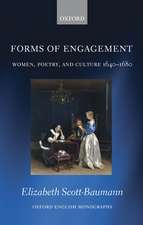The Automaton in English Renaissance Literature: Literary and Scientific Cultures of Early Modernity
Editat de Wendy Beth Hymanen Limba Engleză Paperback – 15 noi 2016
| Toate formatele și edițiile | Preț | Express |
|---|---|---|
| Paperback (1) | 489.26 lei 6-8 săpt. | |
| Taylor & Francis – 15 noi 2016 | 489.26 lei 6-8 săpt. | |
| Hardback (1) | 1058.65 lei 6-8 săpt. | |
| Taylor & Francis – 28 aug 2011 | 1058.65 lei 6-8 săpt. |
Din seria Literary and Scientific Cultures of Early Modernity
- 23%
 Preț: 322.12 lei
Preț: 322.12 lei - 13%
 Preț: 338.33 lei
Preț: 338.33 lei - 26%
 Preț: 822.01 lei
Preț: 822.01 lei - 22%
 Preț: 324.16 lei
Preț: 324.16 lei -
 Preț: 469.34 lei
Preț: 469.34 lei -
 Preț: 469.34 lei
Preț: 469.34 lei - 18%
 Preț: 1120.23 lei
Preț: 1120.23 lei - 16%
 Preț: 260.73 lei
Preț: 260.73 lei -
 Preț: 469.34 lei
Preț: 469.34 lei -
 Preț: 489.26 lei
Preț: 489.26 lei - 13%
 Preț: 309.88 lei
Preț: 309.88 lei -
 Preț: 489.26 lei
Preț: 489.26 lei -
 Preț: 389.38 lei
Preț: 389.38 lei - 26%
 Preț: 764.45 lei
Preț: 764.45 lei - 26%
 Preț: 765.59 lei
Preț: 765.59 lei - 26%
 Preț: 792.44 lei
Preț: 792.44 lei
Preț: 489.26 lei
Nou
Puncte Express: 734
Preț estimativ în valută:
93.64€ • 97.39$ • 78.47£
93.64€ • 97.39$ • 78.47£
Carte tipărită la comandă
Livrare economică 14-28 martie
Preluare comenzi: 021 569.72.76
Specificații
ISBN-13: 9781138262195
ISBN-10: 1138262196
Pagini: 224
Dimensiuni: 156 x 234 x 21 mm
Greutate: 0.45 kg
Ediția:1
Editura: Taylor & Francis
Colecția Routledge
Seria Literary and Scientific Cultures of Early Modernity
Locul publicării:Oxford, United Kingdom
ISBN-10: 1138262196
Pagini: 224
Dimensiuni: 156 x 234 x 21 mm
Greutate: 0.45 kg
Ediția:1
Editura: Taylor & Francis
Colecția Routledge
Seria Literary and Scientific Cultures of Early Modernity
Locul publicării:Oxford, United Kingdom
Cuprins
Contents: Introduction, Wendy Beth Hyman; Part 1 Creations, Creatures, and Origins: Descartes avec Milton: the automata in the garden, Scott Maisano; 'To me comes a creature': recognition, agency, and the properties of character in Shakespeare's The Winter's Tale, Justin Kolb; Antique myth, early modern mechanism: the secret history of Spenser's Iron Man, Lynsey McCulloch. Part 2 Motion: Orpheus and the poetic animation of the natural world, Leah Knight; The mechanical saint: early modern devotion and the language of automation, Brooke Conti; Arrow, acrobat, and phoenix: on sense and motion in English civic pageantry, Michael Witmore. Part 3 Performance and Deception: 'More than art': clockwork automata, the extemporizing actor, and the Brazen Head in Friar Bacon and Friar Bungay, Todd Andrew Borlik; 'Mathematical experiments of long silver pipes'; the early modern figure of the mechanical bird, Wendy Beth Hyman; Desire, nature, and automata in the bower of bliss, Nick Davis; Bibliography; Index.
Notă biografică
Wendy Beth Hyman is an assistant professor of English at Oberlin College, USA.
Recenzii
'An exciting collection...the essays cover a stimulating and appealing range of topics, nationalities, major and minor texts, approaches, and subject matter...it is particularly nice to see essays here that pursue representations of automata in literature conceived more broadly than as representations of real-world machinery or attitudes to technology only, the focus of much critical literature to date. This is a welcome expansion and reorientation of our ideas about the issues raised by early modern automata.' Lara Bovilsky, University of Oregon, USA and author of Barbarous Play: Race on the English Renaissance Stage. '... contains several worthy contributions...' Renaissance Quarterly 'The essays collected here offer refreshing insights into the occurrence of automata in early modern literature and culture... the collection brings new insight into the texts and phenomena through this frame of reference of automation in the early modern period.' Sixteenth Century Journal ’...[offers] skilful, often original interpretations of English Renaissance literary works in which some of the most delightful, disturbing and downright bizarre automata (and related fantasies of animation) can be found.’ Seventeenth-Century News
Descriere
The Automaton in English Renaissance Literature features original essays exploring the automaton-from animated statue to anthropomorphized machine-in the poetry, prose and drama of England in the 16th and 17th centuries. Addressing the history and significance of the living machine in early modern literature, the collection places literary automata of the period within their larger aesthetic, historical, philosophical and scientific contexts.














